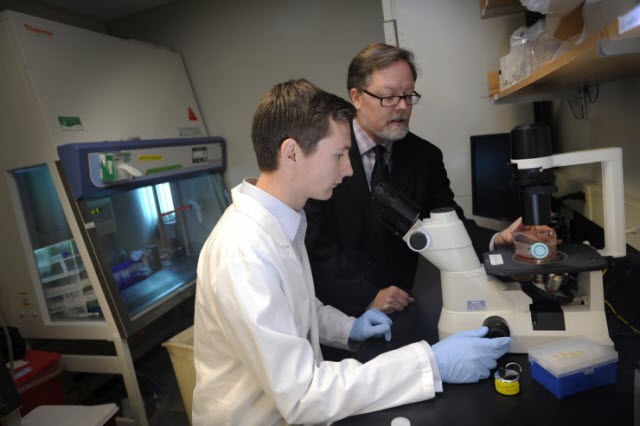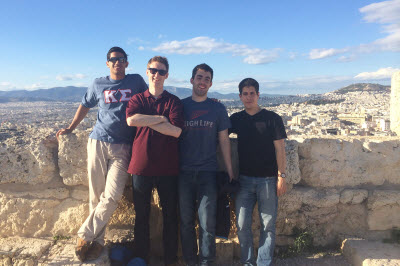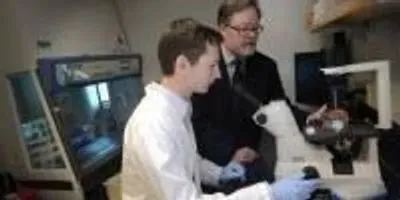 Professor Thomas Webster, right, faculty advisor for the chemical-engineering Global Exchange Program, works with former Exchange student Alexander Colville, E'15, in the Webster Nanomedicine Lab.Photo credit: Matthew Modoono/Northeastern UniversityOn Dec. 5, 2012, professor Thomas Webster had a lightbulb moment.
Professor Thomas Webster, right, faculty advisor for the chemical-engineering Global Exchange Program, works with former Exchange student Alexander Colville, E'15, in the Webster Nanomedicine Lab.Photo credit: Matthew Modoono/Northeastern UniversityOn Dec. 5, 2012, professor Thomas Webster had a lightbulb moment.
Webster, the Art Zafiropoulo Chair in Engineering and the chair of Northeastern’s chemical engineering department, was addressing the 90-plus undergraduates packed into Shillman Hall for the first chemical engineering town hall meeting. “How many of you have done work overseas related to chemical engineering?” he asked.
Only two hands went up.
“How many of you have done research at another university, either in the U.S. or abroad?”
A couple more students nodded.
“That’s when I thought: ‘Why not put the two ideas together—a university-research opportunity overseas for chemical engineers?’” says Webster.
A program is born
Webster, who pioneered the use of nanotechnology for improving medical devices, knows the value of international research experiences for chemical engineering students: They expand students’ scientific and cultural perspectives, and provide insight into other countries’ regulatory and approval processes. Such insight could not only spark advances in research methodology on both sides of the ocean; it could also give students an edge in knowing where to fast-track biomedical products—a boon for subsequent co-??op and work placements.
But he knows, too, that such opportunities are limited because of the extensive in-class course requirements of the major.
All of that factored into the development of Northeastern’s chemical engineering Global Exchange Program, a two-month summer practicum that Webster launched in 2014 to offer undergraduates the chance to earn upper-level engineering credits by performing hands-on research in seven universities around the world. The program also gives students at those universities a chance to do research at Northeastern.
‘This is real research’
 Graphic credit: Luis Delgado/?Northeastern UniversityThe research projects in the program run the gamut: from building bone-like materials (at Chalmers University of Technology, in Sweden) to developing implantable biosensors that can diagnose human disease (Gachon University, in South Korea) to using Big Data to understand complex systems such as cells and economies (Universitat Rovira i Virili, or URV, in Spain).
Graphic credit: Luis Delgado/?Northeastern UniversityThe research projects in the program run the gamut: from building bone-like materials (at Chalmers University of Technology, in Sweden) to developing implantable biosensors that can diagnose human disease (Gachon University, in South Korea) to using Big Data to understand complex systems such as cells and economies (Universitat Rovira i Virili, or URV, in Spain).
Northeastern students apply for the position they want on the program’s website, and faculty at the host institution approve their credentials. Northeastern faculty whose labs are part of the exchange approve the students who come here as well.
“Because our students are abroad for only a short period of time, we have them Skype with the faculty mentor before they go so they fully understand the program, the nature of their research, and what they are supposed to accomplish,” says Webster. At the end of the summer, the students present their work in a formal setting to Webster and each lab’s advisors, podium and all.
He says that he and the faculty mentors have been so impressed by the students’ level of research that they have suggested that many present their findings to the American Institute of Chemical Engineers or the European Society for Biomaterials, or even publish it. “We had one student who published his work in two papers in very high-impact journals based on this exchange,” says Webster. “This is real research the students are doing.”
Recognition and new directions
Alexander J. Colville, E’15, remembers when he heard that his exchange-program research would be published. For five days a week in the summer of 2014, Colville ran computer simulations in a lab atURV to study the thermoynamic properties of materials that would make up the microscopic particles—or nanoparticles—in which drugs could be encapsulated and delivered inside the body. Those properties determine such actions as how fast the drug will be released and how accurate it will be at reaching its target.
“The different perspectives I got about computer modeling research were invaluable,” says Colville, who had completed a co-op in a biotechnology company in the Boston area, where he tested the effectiveness of nanoparticle drug delivery but had never done the theoretical modeling work that helps shape the particles themselves. “With computer modeling you can save so much time as opposed to just experimenting with different combinations of materials in the lab.”
In March Colville’s work appeared in papers in two journals: Langmuir and the Journal of Chemical Physics—a high point. “For the two months I was a workhorse and running the simulations, generating all our data,” he says. “It felt so cool to be a co-author on a paper.”
For Jelle Penders, a master’s student in materials chemistry and nanotechnology at Chalmers University, working in Webster’s lab synthesizing nontoxic gold nanoparticles that reduced bacterial infection in human cells opened up a new direction for his thesis.
“Being able to work under the supervision of one of the world’s frontrunners in the field of nanomedicine was an amazing opportunity,” Penders says. “The experience impacted the direction of research I want to continue in: working with bacteria and human cells in the field of nanomedicine to improve healthcare.”
 Northeastern students on the Global Exchange Program at Universitat Rovira i Virgili, in Spain, enjoy a side trip to Athens, summer 2014.Photo credit: Nafsika Gjika, E ’15Northeastern undergraduate Emily J. Spiel, E’17, exemplifies how accepting the program is of aspiring students. Spiel had never conducted lab research before going to URV this past summer. But she quickly got up to speed, applying her newfound knowledge to studying how nanofibers and nanodroplets formed when an electrical field was applied to a drop of polymer-laced liquid. The research will inform the creation of micro– and nano-structures for use in fields such as optics and energy.
Northeastern students on the Global Exchange Program at Universitat Rovira i Virgili, in Spain, enjoy a side trip to Athens, summer 2014.Photo credit: Nafsika Gjika, E ’15Northeastern undergraduate Emily J. Spiel, E’17, exemplifies how accepting the program is of aspiring students. Spiel had never conducted lab research before going to URV this past summer. But she quickly got up to speed, applying her newfound knowledge to studying how nanofibers and nanodroplets formed when an electrical field was applied to a drop of polymer-laced liquid. The research will inform the creation of micro– and nano-structures for use in fields such as optics and energy.
“Before I went to Spain, my advisors asked me upfront what I knew,” she says. “I told them the classes that I’d taken, and they gave me papers to read. Everyone was very understanding: When you didn’t know something, people helped you learn it. They understood that this was a learning experience for us as well as providing help for them.”
Spiel relished the independence the program permitted as well as meeting people from various countries. The doctoral candidates in her lab were from Greece and Hungary, and she forged bonds with Spanish student-researchers in other labs.
“I don’t think I’ll ever have an experience like that again,” says Spiel, who counts as one of her after-work highlights viewing the human tower competition in the city of Tarragona, where URV is located. “I got to experience what the country was like because I got to know people who lived in the city by talking to everyone in all the labs. It was an incredible experience—something everyone should be able to do.”
On Dec. 5, 2012, professor Thomas Webster had a lightbulb moment.
Webster, the Art Zafiropoulo Chair in Engineering and the chair of Northeastern’s chemical engineering department, was addressing the 90-plus undergraduates packed into Shillman Hall for the first chemical engineering town hall meeting. “How many of you have done work overseas related to chemical engineering?” he asked.
Only two hands went up.
“How many of you have done research at another university, either in the U.S. or abroad?”
A couple more students nodded.
“That’s when I thought: ‘Why not put the two ideas together—a university-research opportunity overseas for chemical engineers?’” says Webster.
A program is born
Webster, who pioneered the use of nanotechnology for improving medical devices, knows the value of international research experiences for chemical engineering students: They expand students’ scientific and cultural perspectives, and provide insight into other countries’ regulatory and approval processes. Such insight could not only spark advances in research methodology on both sides of the ocean; it could also give students an edge in knowing where to fast-track biomedical products—a boon for subsequent co-??op and work placements.
But he knows, too, that such opportunities are limited because of the extensive in-class course requirements of the major.
To continue reading this article, sign up for FREE to

Membership is FREE and provides you with instant access to eNewsletters, digital publications, article archives, and more.



 Professor Thomas Webster, right, faculty advisor for the chemical-engineering Global Exchange Program, works with former Exchange student Alexander Colville, E'15, in the Webster Nanomedicine Lab.
Professor Thomas Webster, right, faculty advisor for the chemical-engineering Global Exchange Program, works with former Exchange student Alexander Colville, E'15, in the Webster Nanomedicine Lab.









